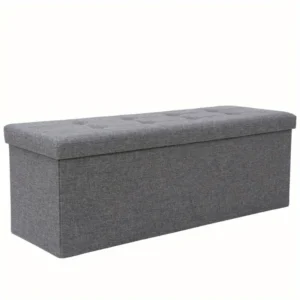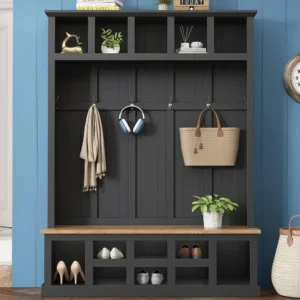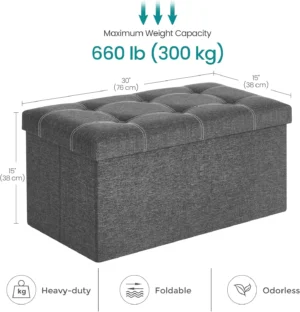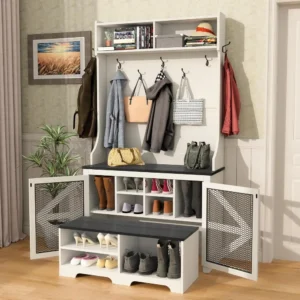Why a Mudroom Bench with Cubbies and Seat is Essential for Home Organization
A mudroom bench with cubbies and seat combines three critical elements for entryway organization: comfortable seating, convenient storage, and clutter control. This multipurpose piece of furniture serves as the command center for your home’s entrance, creating an organized transition space between the outdoors and your clean living areas.
Most homes struggle with common entryway challenges that these specialized benches effectively solve:
- Piles of shoes scattered across the floor creating trip hazards
- Nowhere to sit when putting on or removing footwear
- Backpacks, sports equipment, and bags cluttering valuable floor space
- Coats and jackets draped over furniture or doorknobs
- Disorganized appearance that creates stress upon entering your home
The benefits of incorporating a mudroom bench with cubbies extend far beyond simple organization:
- Dedicated seating area makes the daily routine of changing shoes comfortable and convenient
- Organized storage compartments keep everyone’s belongings separate and easy to find
- Significantly reduced clutter creates a cleaner, more welcoming entrance
- Improved traffic flow allows family members to enter and exit without congestion
- Enhanced home aesthetics transforms a functional space into a stylish first impression
By transforming your entryway with space-saving benches, you create a system that works for your family’s specific needs while adding style to your home. These versatile pieces adapt to various household sizes and daily routines, making them essential for maintaining organization.
When considering options for your entryway, exploring quality mudroom bench cubbies can help you find the perfect balance between functionality and design that matches your home’s aesthetic and your family’s organizational needs.
Understanding Your Space and Needs Before Shopping
A. Measuring Your Space Correctly
Before falling in love with a specific mudroom bench, taking accurate measurements of your available space is crucial. This simple step prevents disappointment and ensures your new furniture fits perfectly in your entryway.
Start with these essential measurements:
- Width: Measure the wall space where the bench will sit, accounting for any trim or moldings
- Depth: Determine how far the bench can extend into the room without obstructing walkways (18-24 inches or 45-60 cm is typical)
- Height: Measure from floor to ceiling, especially important if considering a tall hall tree design
- Doorway clearance: Ensure the bench won’t block door swing paths or interfere with traffic flow
Don’t forget to note potential obstacles that might affect placement:
- Electrical outlets and light switches
- Heating/cooling vents
- Baseboards that may require the bench to sit slightly away from the wall
- Windows that could be blocked by taller units
Common measurement mistakes to avoid include forgetting to account for door swing space, underestimating the depth needed for comfortable seating, and not allowing enough clearance for foot traffic. A tape measure and level are essential tools for this process.
When working with limited space, maximizing small spaces with smart entryway benches becomes especially important. Proper measurements help you identify space-saving designs that still meet your organizational needs.
B. Identifying Your Storage Requirements
To select a bench with the right amount and type of storage, take inventory of what items need homes in your entryway. Consider creating a checklist of everything currently cluttering your entrance area:
- How many family members need dedicated storage space?
- What types of footwear need storage? (athletic shoes, work boots, kids’ shoes)
- Do you need storage for seasonal items like gloves, hats, and scarves?
- Are there bags, backpacks, or purses that regularly need a home?
- Do you need space for pet supplies like leashes and waste bags?
Family size significantly impacts your storage needs. A household with four members will typically require at least 4-8 cubbies for adequate shoe storage alone. Households with children should consider how storage needs will evolve as they grow.
Special considerations include:
– Families with young children benefit from lower, easily accessible cubbies
– Pet owners might need washable surfaces and space for pet supplies
– Households in variable climates need flexible storage for seasonal items
For footwear specifically, exploring specialized mudroom benches with shoe storage can help you find designs specifically created to handle the volume and type of shoes your family uses daily.
C. Matching Style with Your Home Décor
Your mudroom bench should complement your home’s existing style rather than clash with it. Taking time to identify your current décor style helps narrow your choices to pieces that will look intentional and cohesive.
Common design styles and their mudroom bench characteristics:
- Farmhouse: Distressed finishes, natural wood tones, simple hardware, and rustic details
- Modern: Clean lines, minimal ornamentation, contrasting materials like metal and wood
- Traditional: Rich wood tones, detailed woodwork, classic proportions
- Coastal: Light finishes, blue/green accents, natural textures
- Industrial: Metal elements, exposed hardware, reclaimed wood, darker finishes
Consider these aspects when matching your bench to your home’s style:
– Hardware finish (brushed nickel, oil-rubbed bronze, matte black)
– Wood tone or paint color
– Design details (simple vs. ornate)
– Material combinations
For homes with specific design preferences, exploring farmhouse mudroom benches or other style-specific collections can help you find pieces that perfectly complement your existing décor while providing the organization you need.
Types of Mudroom Benches with Cubbies and Seats
A. Freestanding vs. Built-in Options
When exploring mudroom bench options, one of the first decisions is whether to choose a freestanding or built-in design. Each offers distinct advantages depending on your situation.
Freestanding Benches:
– Portable and can move with you if you relocate
– No installation required beyond simple assembly
– Available in countless ready-made designs
– Lower initial cost (typically $150-800)
– Can be easily replaced or upgraded
– Ideal for renters or those who may move
Built-in Benches:
– Custom-fitted to your exact space dimensions
– Maximizes every inch of available space
– Looks integrated with your home architecture
– Can incorporate custom features specific to your needs
– Higher initial investment ($800-3000+ depending on materials)
– Potentially increases home value
– Better for homeowners planning to stay long-term
For most homeowners, the decision comes down to permanence and investment level. Renters and those in temporary living situations benefit from the flexibility of freestanding options, while homeowners looking for a permanent solution often prefer built-ins for their seamless integration.
When working with challenging layouts, learning how to organize a small entryway with bench solutions can help you decide whether freestanding or built-in designs make more sense for your specific constraints.
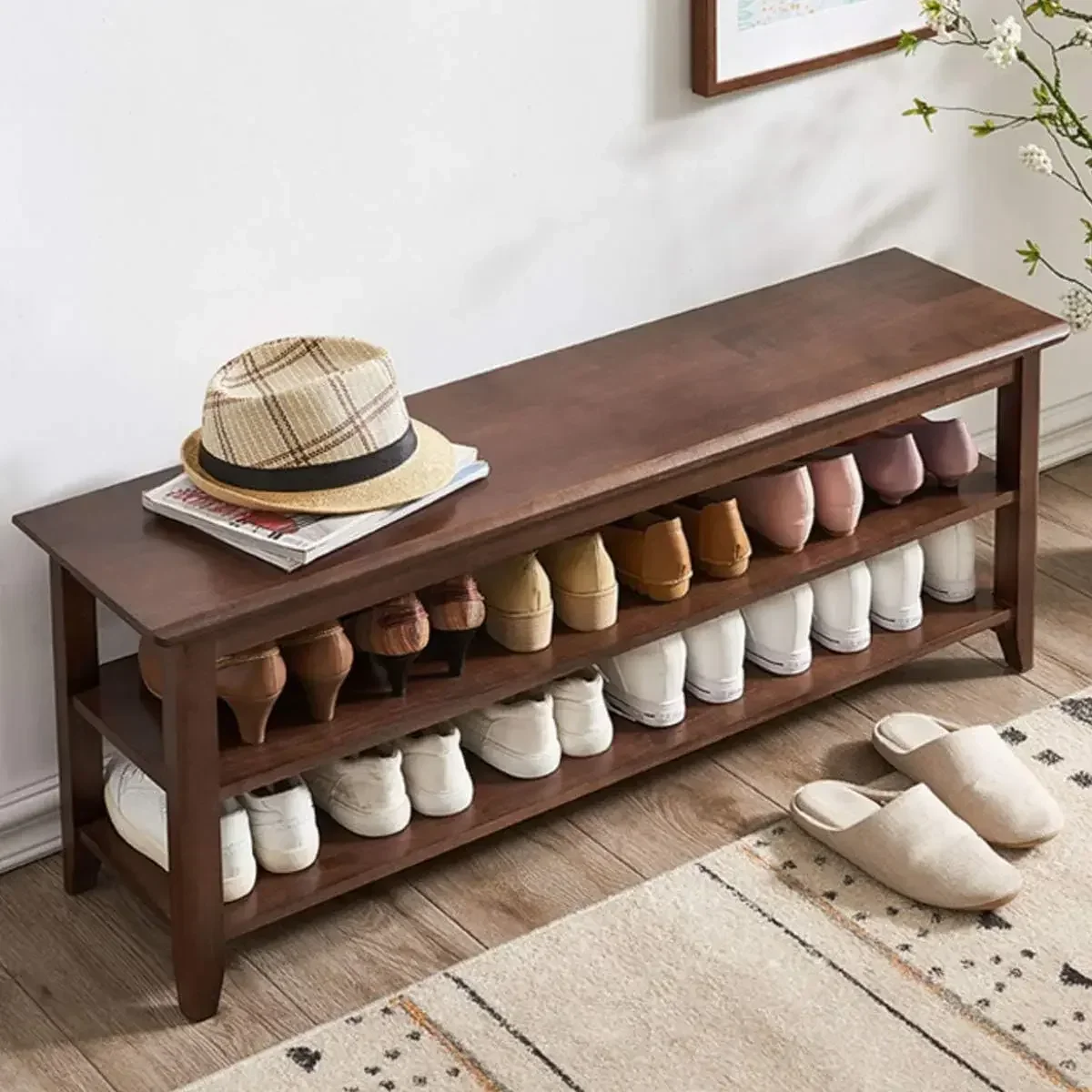
B. Open vs. Closed Cubby Designs
The design of your storage cubbies significantly impacts both functionality and appearance. Both open and closed designs offer distinct advantages.
Open Cubbies:
– Provide easy visibility and quick access to items
– Create a more casual, accessible look
– Allow air circulation around damp shoes or gear
– Typically cost less than closed designs
– Encourage regular organization (as items remain visible)
– Work well with decorative baskets and bins
Closed Cubbies (with doors/drawers):
– Hide clutter from view for a cleaner appearance
– Protect items from dust
– Offer a more formal, finished look
– Provide better long-term storage for seasonal items
– Allow for locking options for valuable items
– Typically cost more due to additional materials and hardware
For families with young children, open cubbies often work better for daily use items, making it easier for kids to put away their belongings. Pet owners might prefer closed storage for items they don’t want pets accessing.
For versatile storage options, entryway benches with shelf storage combine open shelving with comfortable seating, offering a balance between visibility and organization.
C. Hall Trees with Integrated Bench and Storage
Hall trees represent a comprehensive solution for entryways, combining a bench, cubbies, and vertical storage in one unified piece. These full-height units maximize storage capacity in a single footprint.
Key features of hall trees include:
– Vertical coat hooks for hanging outerwear
– Upper shelving for seasonal items or decorative pieces
– Mirror options for last-minute appearance checks
– Bench seating with shoe storage beneath
– Umbrella stands or specialized compartments
Hall trees typically require:
– Ceiling height of at least 6.5 feet (2 meters)
– Floor space of approximately 3-4 feet wide by 1-2 feet deep (90-120 cm by 30-60 cm)
– Wall space that can accommodate a taller piece
While they require more space than a simple bench, hall trees provide significantly more storage capacity. They work exceptionally well for households with limited closet space or those wanting to create a defined entryway in an open floor plan.
For comprehensive entryway solutions, exploring entryway hall trees provides options that combine vertical and horizontal storage with comfortable seating in one cohesive unit.
Essential Features to Consider for Maximum Functionality
A. Ideal Dimensions for Comfort and Practicality
Finding the right dimensions ensures your mudroom bench is both comfortable and functional for daily use. Industry standards and ergonomic guidelines provide helpful starting points.
Optimal Bench Height:
– 17-20 inches (43-50 cm) from floor to seat top
– Lower heights (17-18 inches or 43-46 cm) work better for households with children
– Higher heights (19-20 inches or 48-50 cm) may be more comfortable for taller adults
Ideal Seat Depth:
– 15-18 inches (38-46 cm) provides adequate support without taking up excessive space
– Deeper seats (16-18 inches or 40-46 cm) offer more comfort for longer sitting periods
– Shallower seats save valuable floor space in tight entryways
Cubby Dimensions:
– Individual shoe cubbies: 12 inches wide × 6-8 inches high × 12-15 inches deep (30 × 15-20 × 30-38 cm)
– General storage cubbies: 12-16 inches in all dimensions (30-40 cm)
– Basket-compatible cubbies should match standard basket sizes
Total Width Considerations:
– Allow 18-24 inches (46-61 cm) of bench width per person for comfortable seating
– Consider how many people might need to sit simultaneously
– Factor in how much storage each household member requires
Understanding the perfect entryway bench height for your specific household needs ensures comfortable daily use while maintaining proper proportions in your space.
B. Materials and Construction Quality
The materials used in your mudroom bench directly impact its durability, maintenance requirements, and overall lifespan—especially important in this high-traffic area exposed to outdoor elements.
Solid Wood Options:
– Oak: Extremely durable with prominent grain, resistant to wear, moderately expensive
– Maple: Hard, dense wood with subtle grain, excellent durability, higher price point
– Pine: Softer wood, more affordable, may show wear sooner but offers rustic charm
– Walnut: Rich color, excellent durability, premium price point
Engineered Wood Options:
– MDF (Medium Density Fiberboard): Smooth surface, takes paint well, less expensive but vulnerable to moisture
– Plywood: Good structural strength, moderate moisture resistance, mid-range price
– Particle Board: Most economical option but least durable, especially with moisture exposure
Metal Elements:
– Steel: Strong, durable, works well for frames and accents
– Wrought iron: Decorative, extremely strong, suits traditional and industrial styles
– Aluminum: Lightweight, resistant to corrosion, modern appearance
For weight capacity, look for benches rated for at least 250-300 pounds (113-136 kg) for regular daily use. Construction quality indicators include dovetail or mortise-and-tenon joinery, reinforced corners, and minimal use of staples.
Homes with limited space often benefit from creative solutions, and exploring small home mudroom bench solutions can help you find durable options specifically designed for compact areas.
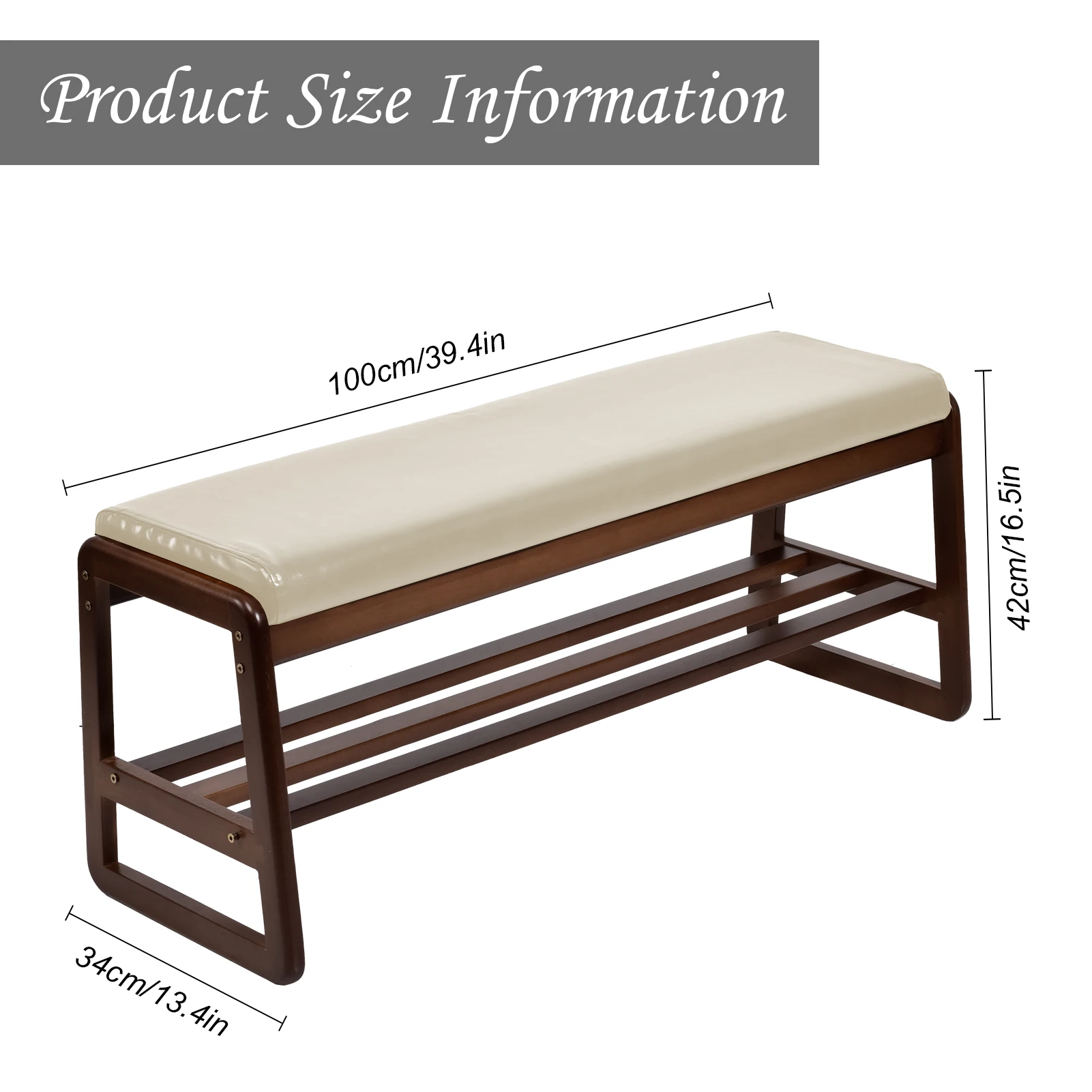
C. Seating Comfort and Design Options
While functionality drives many mudroom bench decisions, seating comfort remains essential for daily use, especially during longer periods like putting on boots or lacing up athletic shoes.
Cushioned vs. Hard Seating Surfaces:
– Cushioned seats offer greater comfort, especially for longer sitting periods
– Hard surfaces provide durability and easier cleaning
– Some designs feature flip-top storage with cushioning on top for a best-of-both-worlds approach
Fabric Selection Considerations:
– Performance fabrics (like Sunbrella or Crypton) resist stains, fading, and moisture
– Vinyl or faux leather options offer easy cleaning with a simple wipe-down
– Removable covers allow for washing or seasonal changes
– Outdoor fabric technologies provide indoor comfort with improved durability
Cushion Attachment Options:
– Removable cushions: Easier to clean or replace, can be stored during messy seasons
– Attached cushions: Won’t slide or get lost, typically more streamlined appearance
– Hinged cushions: Allow access to storage beneath without removing the cushion
For optimal comfort, look for cushions with at least 2-3 inches (5-7.5 cm) of padding with firm support underneath. Memory foam options provide excellent comfort while maintaining their shape over time.
D. Additional Storage Features Worth Having
Beyond basic cubbies, several additional storage features can dramatically enhance your mudroom bench’s functionality and organization potential.
Coat Hooks and Optimal Placement:
– Adult coat hooks: 60-72 inches (152-183 cm) from the floor
– Children’s hooks: 36-48 inches (91-122 cm) from the floor
– Allow 8-12 inches (20-30 cm) between hooks to prevent crowding
– Look for hooks rated for at least 10-15 pounds (4.5-6.8 kg) each
Overhead Shelving Benefits:
– Creates storage for less frequently used items
– Keeps seasonal accessories organized but accessible
– Provides display space for decorative elements
– Typically located 12-18 inches (30-46 cm) above coat hooks
Drawer Storage Advantages:
– Conceals small items like keys, gloves, and pet supplies
– Prevents small items from getting lost in larger cubbies
– Adds a finished look to the overall design
– Works well for items accessed daily but not displayed
Basket and Bin Integration:
– Creates movable, washable storage within cubbies
– Allows for seasonal rotation of contents
– Adds texture and visual interest to open storage
– Enables color-coding or labeling for different family members
Entryway Bench with Shelf Storage, Shoe Bench for Entryway, Shoe Storage Bench
$194.08 Select options This product has multiple variants. The options may be chosen on the product pageBench with Hooks and Storage, Entryway Hall Tree, Mudroom Bench with Cubbies, Mudroom Bench with Shoe Storage
$818.38 Select options This product has multiple variants. The options may be chosen on the product pageEntryway Coat Rack Bench, Entryway Hall Tree, Farmhouse Mudroom Bench, Mudroom Bench with Shoe Storage
$805.09 Select options This product has multiple variants. The options may be chosen on the product pageEntryway Bench with Shelf Storage, Small Shoe Bench
$151.16 Select options This product has multiple variants. The options may be chosen on the product pageBench with Hooks and Storage, Entryway Coat Rack Bench, Entryway Hall Tree, Mudroom Bench with Shoe Storage, Mudroom Coat Rack Bench
$793.73 Select options This product has multiple variants. The options may be chosen on the product pageCoat Rack Shoe Bench, Entryway Coat Rack Bench, Entryway Hall Tree, Wood Entryway Bench
$479.82 Select options This product has multiple variants. The options may be chosen on the product page
Our Top Recommended Mudroom Benches for Different Needs
A. Best Overall Mudroom Bench with Cubbies and Seat
Our top all-around performer combines versatile storage options with comfortable seating and durable construction. This balanced design from Nested Goods features solid wood construction with a moisture-resistant finish perfect for entryway conditions.
Key Specifications:
– Dimensions: 48 inches wide × 16 inches deep × 20 inches high (122 × 41 × 51 cm)
– Materials: Solid pine with reinforced joinery and water-resistant finish
– Weight Capacity: 350 pounds (159 kg)
– Storage: 6 standard cubbies with 2 additional hidden compartments
– Seating: Foam-padded cushion with stain-resistant fabric
What makes this bench exceptional is its thoughtful balance of features. The proportions accommodate most entryways while providing ample storage for a family of four. The classic design elements blend with various home styles, and the quality construction ensures years of reliable service despite daily use.
B. Best Space-Saving Option for Small Entryways
For homes with limited entryway space, compact design becomes crucial without sacrificing essential functionality. Our recommended space-saving option maximizes vertical storage while minimizing floor footprint.
Key Specifications:
– Dimensions: 32 inches wide × 14 inches deep × 68 inches high (81 × 36 × 173 cm)
– Materials: Engineered wood with solid wood accents and metal hardware
– Weight Capacity: 250 pounds (113 kg)
– Storage: 4 shoe cubbies, 8 coat hooks, upper shelf
– Seating: Compact cushioned bench with storage beneath
This clever design utilizes vertical wall space that often goes unused in small entryways. Despite its compact footprint, it accommodates storage for 2-3 people with a mix of open and closed storage options. The bench itself provides comfortable seating without extending too far into valuable floor space.
For more ideas on maximizing limited areas, exploring space-saving entryway ideas provides additional strategies beyond furniture selection.
C. Best Premium Option for Lasting Quality
For those seeking investment-quality furniture that will stand the test of time, our premium recommendation focuses on superior craftsmanship and materials that justify the higher price point.
Key Specifications:
– Dimensions: 54 inches wide × 18 inches deep × 22 inches high (137 × 46 × 56 cm)
– Materials: Solid maple with dovetail joinery and catalyzed lacquer finish
– Weight Capacity: 500 pounds (227 kg)
– Storage: 8 cubbies with adjustable dividers, soft-close drawers
– Seating: High-density foam cushion with performance fabric
This bench distinguishes itself through exceptional attention to detail, including hand-finished surfaces, precision joinery, and materials selected for generational durability. The adjustable storage configuration adapts to changing needs, while the commercial-grade finish resists moisture, scratches, and daily wear. Though significantly more expensive than basic options, this bench represents a one-time purchase that will serve for decades.
D. Most Versatile Design for Changing Needs
Households with evolving storage needs benefit from adaptable designs that can transform over time. Our versatile recommendation features modular elements that can be reconfigured as requirements change.
Key Specifications:
– Dimensions: 48 inches wide × 16 inches deep × 18 inches high (122 × 41 × 46 cm)
– Materials: Solid wood frame with metal accents
– Weight Capacity: 300 pounds (136 kg)
– Storage: Modular cubbies with removable dividers, adjustable shelving
– Seating: Flip-top storage bench with cushioned lid
The standout feature of this design is its adaptability. The removable dividers allow cubby spaces to be combined or separated as needed. The modular nature means sections can be added or reconfigured without replacing the entire unit. This bench transitions seamlessly between different seasons and evolving family needs, making it ideal for growing households.

Styling and Organization: Maximizing Your Mudroom Bench
A. Strategic Use of Baskets and Bins
Baskets and bins transform basic cubby spaces into organized, attractive storage while adding texture and visual interest to your entryway. The right containers make daily organization simpler while enhancing your bench’s functionality.
Tips for effective basket implementation:
- Size considerations: Measure cubbies before purchasing baskets, allowing ½ inch (1.3 cm) clearance on all sides for easy removal
- Material selection: Choose based on contents and cleaning needs:
- Plastic bins: Washable, durable, ideal for muddy items
- Fabric bins: Softer appearance, good for clothing and accessories
- Woven baskets: Add texture and natural elements, best for dry items
Wire baskets: Provide visibility and airflow, good for damp items
Labeling strategies: Clear identification improves family compliance with organization:
- Color-coding by family member
- Picture labels for young children
- Chalkboard or removable labels for changing contents
Selecting containers that complement your bench’s style creates a cohesive look while improving functionality. Even the most basic bench can look custom when fitted with matching, high-quality baskets.
Families with multiple children particularly benefit from organized systems. Exploring mudroom bench layouts for families provides additional strategies for creating personalized storage that grows with your children.
B. Seasonal Rotation Strategies
Maintaining an organized entryway throughout the year requires strategic seasonal rotations that anticipate changing needs. A thoughtful approach prevents overflow and keeps daily essentials accessible.
Winter Organization:
– Front-and-center access for hats, gloves, scarves
– Boot trays for snow and salt management
– Extra hooks for bulky coats and snow gear
– Basket for hand warmers and other winter accessories
Spring/Fall Transitions:
– Equal space for lightweight and heavier jackets
– Accessible umbrella storage
– Dual storage for seasonal footwear options
– Waterproof containment for rainy conditions
Summer Organization:
– Minimized coat storage
– Increased space for sunscreen, hats, sunglasses
– Storage for beach/pool items
– Bins for sports equipment and outdoor toys
The key to successful seasonal rotation is anticipating needs about two weeks before the weather actually changes. Store off-season items in clearly labeled containers either high on mudroom shelves or in separate storage areas like basement bins or under-bed containers.
C. Accessorizing for Style and Function
The right accessories transform a basic mudroom bench into both a functional space and an attractive entry point for your home. These thoughtful additions enhance both the practicality and aesthetic appeal of your entryway.
Functional Accessories:
– Full-length or wall mirrors for final appearance checks
– Boot trays to contain moisture and dirt
– Key hooks or small dishes for everyday essentials
– Weather-resistant indoor/outdoor rug to trap dirt
– Umbrella stand for wet weather gear
Decorative Elements That Enhance Functionality:
– Wall art that complements your home’s style
– Task lighting to illuminate the space
– Small plants to add life (consider low-maintenance varieties)
– Seasonal décor that can be easily changed
– Personalized elements like family photos or monogrammed items
For visual balance, follow the rule of odd numbers (groupings of 3 or 5) when arranging decorative elements. Keep proportions appropriate to your space—oversized pieces overwhelm small areas, while tiny accessories get lost in larger entryways.
Common Mistakes to Avoid When Selecting and Installing Your Bench
Choosing a bench that’s too large or too small for your space
Many homeowners select benches based on appearance without properly measuring their available area. This leads to overcrowded entryways or benches that look lost in the space. Always start with accurate measurements and leave adequate clearance for doors and traffic flow.Underestimating your storage requirements
A common error is selecting a bench with insufficient storage for your household’s needs. Count how many pairs of shoes, bags, and accessories need homes before choosing your bench size. Remember that most households need more storage than they initially estimate.Selecting materials inappropriate for your climate and usage
Entryways endure significant wear and moisture exposure. Choosing porous materials or fabrics that aren’t water-resistant in rainy climates leads to premature deterioration. Match your materials to your specific environmental conditions and family lifestyle.Improper installation that compromises stability
Freestanding benches must be level to prevent tipping, while built-ins require secure wall attachment. Skip proper installation, and you risk furniture damage or even injury. Follow all manufacturer guidelines and consider professional installation for built-in units.Prioritizing appearance over functionality
While style matters, selecting a bench solely for its looks often results in frustration with its daily usability. Balance aesthetic considerations with practical features that support your daily routines and storage needs.Failing to consider maintenance requirements
Different materials and designs require varying levels of cleaning and upkeep. Choosing high-maintenance options without considering your available time leads to premature wear. Select materials and finishes that align with your willingness and ability to maintain them.Not coordinating with surrounding décor
A bench that clashes with your home’s style creates visual disconnection. Consider your existing color scheme, materials, and design aesthetic when selecting your mudroom furniture to create a cohesive entryway that flows with the rest of your home.
Frequently Asked Questions About Mudroom Benches
What’s the ideal height for a comfortable mudroom bench?
The ideal height ranges from 17-20 inches (43-50 cm) from the floor to the top of the seating surface. This height allows most adults to sit comfortably while putting on or removing shoes. For households with children, benches closer to 17 inches (43 cm) provide easier access for little ones.
How wide should each cubby be for adequate shoe storage?
Standard shoe cubbies should be approximately 12 inches wide, 6-8 inches high, and 12-15 inches deep (30 × 15-20 × 30-38 cm). This accommodates most adult shoe sizes. For boots or larger footwear, consider cubbies that are at least 8-10 inches high (20-25 cm).
What materials hold up best in high-moisture environments?
For mudrooms exposed to snow, rain, or high humidity, look for solid hardwoods with moisture-resistant finishes, metal components made from stainless steel or treated for rust resistance, and fabrics specifically designed for outdoor use. Avoid untreated woods, particle board, and standard upholstery fabrics, which can deteriorate quickly with moisture exposure.
How do I clean and maintain my mudroom bench?
For wooden surfaces, use a damp cloth for daily cleaning and apply furniture polish every few months. Cushions with removable covers should be washed according to fabric instructions. For fixed upholstery, vacuum regularly and treat stains promptly with appropriate cleaners. Metal components should be wiped clean and checked periodically for rust or loose connections.
Is assembly difficult for most mudroom benches?
Assembly difficulty varies by design. Simple benches typically require 1-2 hours with basic tools, while complex hall trees may take 3-4 hours and require additional helpers. Most manufacturers provide detailed instructions and necessary hardware, though some may require additional tools like drills or screwdrivers. When in doubt, professional assembly services are worth considering for complex pieces.
How can I prevent shoes from creating odors in enclosed storage?
Use open cubbies rather than closed storage for daily-use shoes to promote air circulation. Add cedar blocks or activated charcoal odor absorbers to storage areas. Consider removable, washable liners for cubbies that hold athletic shoes. Ensure shoes are dry before storing, using boot dryers if necessary for wet footwear.


